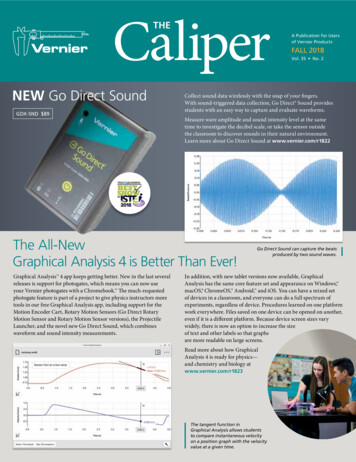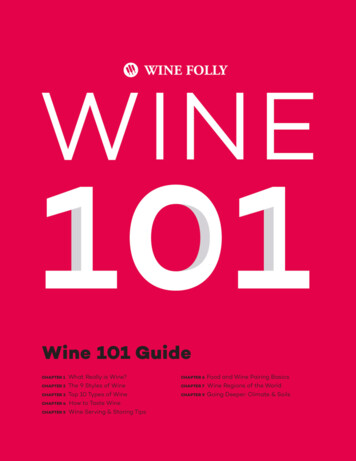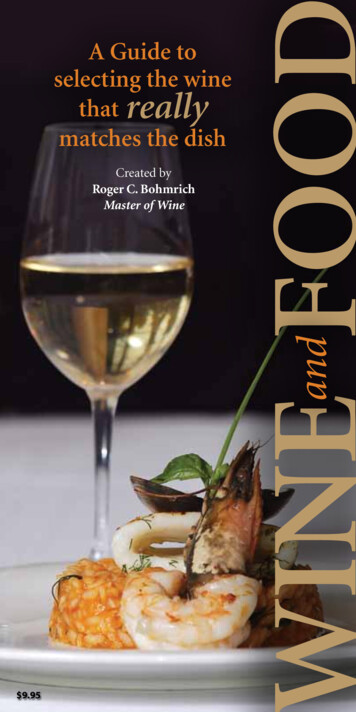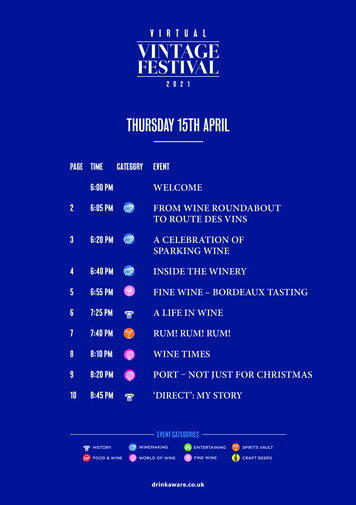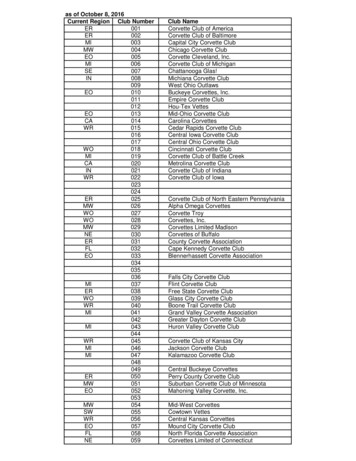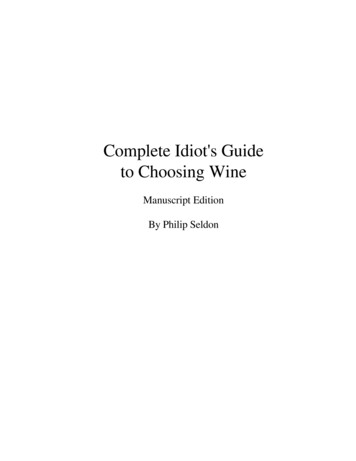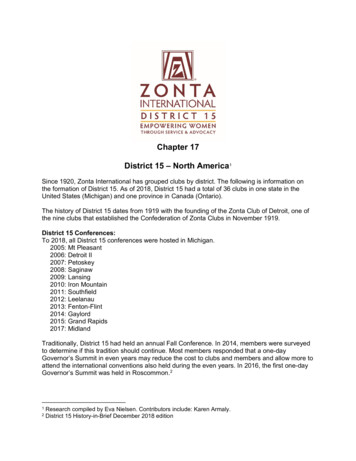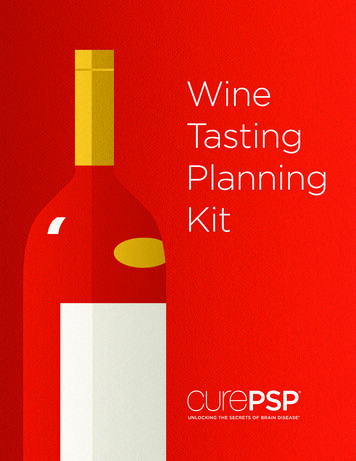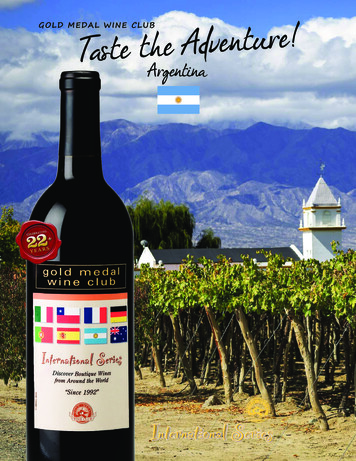
Transcription
GOLD MEDAL WINE CLUB!erutnevdAeTaste thArgentina
ARGENTINA WELCOMESA NEW ERA OF BOUTIQUEPRODUCERS AND FINDS ITS PLACEIN THE INTERNATIONAL MARKET.Like many wine producingcountries, Argentina can traceits wines back many centuries.T h e f i r s t p l a n t i n g s w e rerecorded around 1550, whenSpanish colonizers rooted thefirst vitis vinifera vines in thecountry. Aided by the favorableweather conditions of the AndesMountains, the vines quicklyspread to a number of areasthroughout the country. Aninflux of European immigrantsduring the 19th Century brought new winemaking techniques and additional grapevarietals to the existing vineyards.By the start of the 20th Century, more than 500,000 acres were planted, mostlyfor local consumption. Large production plants were located in key areas that providedcrucial consumption areas with a plentiful supply of Argentine wine. Introduction of softdrinks and beer into the country caused the local wine consumption market to collapse inthe 1970’s. By the early 1990’s, a new era for the Argentine wine industry was formalized.Small quantities of high caliber wines were produced, with an eye toward export andthe high end of local consumption.As in many other countries, this format has proven to be an enormous success.Smallish, boutique-like wineries have won their place in internationalcompetitions with quality wines that accurately reflect the terroir oftheir individual locations. Argentina has quickly become thelargest exporter of wine in South America, and its southernhemisphere location’s growing season (October throughFebruary) gives it a head start on European and Americangrowing competitors. It is also a country devoid of the fearedphylloxera, the pest that has devastated the vineyards of bothEurope and the United States.The turn of this century found more than 1,500 wineries in Argentina, withmany of these in the smaller, boutique categories. More care in farming (reducingthe yield for higher quality) procedures and strict attention to modern winemakingtechniques have made Argentina a main player on the international wine scene.Even though there was a major influx of foreign investment (particularlyfrom France and the United States), a high number of these new wineries areowned by Argentine citizens. This is an important factor and ensures thatadditional wineries will be forthcoming based on the success of locallyowned wineries and vineyards.
Region Spotlight:MendozaPart of this accumulated successshould be given to the internationalacceptance of the Malbec grape that hasreached its zenith in Argentina. Nowhereelse on the planet does this Bordeauxvarietal thrive as it does in Argentina, andits scores and accolades have continuedto mount with each passing vintage.Argentine wineries have beensmart to recognize this and additionalplantings of Malbec will assure of acontinued supply of top quality fruit inthe future.To say that the future looksrosy (red) for Argentine wines issomewhat ludicrous, for the future forthis beautiful part of the world in now.Argentina’s wines will continue to growin quality and popularity as more andmore of these small wineries test theinternational market.This International Seriesselection is happy to introducesome of these fine Argentinewines for your consideration. Wetrust your palate will enjoy themas much as we enjoy the chanceto show you some new, trulyformidable wines.Argentina’s highly successful grape growing region is centered on theCity of Mendoza, in the country’s north-central section. It’s location in the easternfoothills of the great Andes Mountains provides Mendoza with almost idealgrowing conditions and makes the country one of South America’s leading wineproducers, along with neighboring Chile. Nearly two thirds of Argentina’s winesare produced here in addition to a larger percentage of the country’s highestquality wines. Elevations for the vineyards are from 2,800 feet up to 5,000 feet, andare among the highest in the wine producing world. Soil composition throughoutthe entire region is mostly alluvial in nature, composed of loose sand over clay.A number of mountain rivers, fueled by glacial runoff in the Andes, provideexcellent water for thevineyards that are alsosupplied by thousandsof boreholes scatteredthroughout the region.Mendoza has severalsub-regions, includingthe Lujan de CuyoRegion (the region’sfirst appellation, sohonored in 1993), that ishighly esteemed for itsplantings of Argentina’smost successful redgrape, the Malbec.WINE REGIONS OF ARGENTINAKnown as "a land of contrasts," Argentina offers one of the mostdiverse groups of wine growing regions in the world. From thehigh summits of the Andes, to its broad valleys and sloping plains,from the lush forests and absolutely arid deserts, to the woods,glaciers, and waterfalls - Argentina offers any landscape youmay imagine, and thus, a multitude of wine growing possibilities.This wealth of natural ecosystems, paired with the unusually highaverage altitude, and wide range of temperatures, give Argentinewines their unique identity and quality. Argentina also benefitsfrom its overall dryclimate and its natural, Jujuyexceptionallyhigh Saltawaterqualitydue Tucumánto meltwater from CatamarcathenearbyAndes La Riojamountains. The main San Juanwine growing regions Córdobaare Mendoza in the Mendozacentral Cuyo province, La Pampaand Cafayate in the Neuquénnorthern larger wine Río Negrogrowing region of Salta. Chubut
Argentina:Fun Facts!Photos, top to bottom, left to right: Mendoza is one of Argentina's most important wine regions, accounting for nearly two-thirdsof the country's entire wine production. A wine cork from Argentina. Winemaker Roberto de la Mota and architect Anabelle Sielecki formed the award-winningMendel Winery, especially known for its Malbec and Semillon wines.The name Argentina comes from the Latinword for silver, 'argentum.' Soccer is Argentina's most popular sport. Their national football (soccer) team has won theWorld Cup in 1978 and 1986, and hopes to win again this year in the 20th edition of theWorld Cup, hosted in Brazil.By land area, Argentina is the second largestcountry in South America and the eighthlargest country in the world. Malbec is Argentina's flagship variety, and the country has the largest Malbec acreage in theworld. The Uco Valley in Mendoza is home this month's featured Chaman Winery.The Argentine city of Ushuaia is thesouthernmost city in the world.Argentina was the first country to adoptfingerprinting as a method of identification.Argentina produced the first animatedfeature film in 1917.The oldest known dinosaur species havebeen traced back to Argentina and Brazil,making both countries prime destinationsfor paleontologists. Species such as theEoraptor are said to have walked the earthas far back as 230 million years ago.While football (soccer) is without a doubtArgentina's favorite sport, a much lesserknown sport called Pato is the officialnational sport in Argentina. Pato is a gameplayed on horseback, combining theelements of polo and basketball. Pato isSpanish for "duck," since in the game's earlyversions (as early as 1610) a live duck insideof a basket was used instead of a ball.Argentina is the world's fifth largestproducer of wine.It is customary to eat gnocci (potatodumplings) on the 29th of each month,a tradition probably introduced by Italianimmigrants. Gnocci was a cheap meal, idealfor the last days of the month when moneywas tight. As a tourist in Argentina, you maynotice that many restaurants serve a specialgnocci menu on the 29th.Torrontes is a white wine grape that isunique to Argentina. It is similar in style toa Viognier or Muscat, very aromatic andfloral in style.The main wine regions in Argentina areMendoza and Cafayate. These regionsproduce the well-known Malbec and Torrontesvarietals that the country is famous for.THE FLAG OF ARGENTINAThe history of Argentina's flagdates back to 1812, when itwas designed by revolutionarymilitary leader Manuel Belgrano.The white middle band is said torepresent silver (the country wasnamed Argentina after theLatin word 'Argentum,'meaning silver, thinking theregion contained vast amounts of the metal). The blue bandsrepresent the sky, the waters of Argentina's Rio de la Plata, orthe blue used by the Spanish royal house of Bourbon on theircoat of arms. In the center of the flag is a national emblem, a sunsymbol named 'el sol de mayo' (the sun of May), after Argentina'sMay revolution that lead to the nation's independence from Spain.The symbol also pays homage to the Incan sungod Inti, as the ancient Incas worshippedthe sun and its life giving power.Salud!Order Toll Free: 1-800-266-8888 Order by Fax: 1-800-266-8889Order online at: www.goldmedalwineclub.com
two of argentina's top wine producers blend ancient vineyards, apassionate spirit and traditional winemaking techniques to maketop-quality wines in the world-famous mendoza wine-growing region.Bodegas MendelMendozaBodegas Mendel is arelatively new Argentinewinery that was founded in2003 by architect AnabelleSielecki and winemakerRoberto de la Mota. It consistsof an original 15 acres thatdate back to 1926 along withsome newly acquired properties (that the company leases) in differentsections of Mendoza.The partnership formed by Sielecki and de la Mota hasproven to be incredibly successful. The pair chose the best blocksfrom their original (ancient) vineyards and has blended them withequally successful blocks from their newer vineyard acquisitions.For the record, Mendel is the first name of Anabelle Sielecki’sfather. He came to Argentina and became successful in a numberof different businesses. Mendel Sielecki loved the finer things in lifeand was a devotee of fine wines. Anabelle has honored her fatherby seeking perfection in her and Roberto de la Mota’s wines.Roberto de la Mota’s reputation is simply that heconsistently makes wines of classic structure, elegance and finesse,unlike the hulking, over-plush, over-oaked wines that some modernArgentine producers have popularized.The Winemaker: Roberto de la MotaSon of legendary Argentinewinemaker Raul de la Mota, Robertohas been making wines for almost fourdecades. De la Mota graduated from theSchool Technico Agraria Michel Pougetin Mendoza in 1979 with a Bachelor ofAgricultural Technical and Oenologistdegree. He apprenticed under his fatherat Bodegas Weinert and also worked for the legendary Frenchenologist Emile Peynaud in Bordeaux. He was also winemaker forthe prestigious Bodegas Chandon and headed their joint venturewith Chateau Cheval Blanc that was called Cheval de los Andes.The project began more than a decade ago and was met withgreat critical acclaim and success. Now 54, de la Mota is partiallyparalyzed from a car accident, but shows no signs of slowing down.He is well known for introducing the Mendel Semillon, the onlyserious Semillon produced in Argentina.Bodegas ChamanSan Carlos, Uco Valley, MendozaThis winery traces its roots back many decades throughthe Reginato family and its vineyard holdings. Family patriarch JoseReginato planted the original vineyards more than 50 years agoand took special care to match the vines with the individual microclimates that his land enjoyed. He still oversees the vineyard partof the Bodegas Chaman operation and assures near perfect fruitfrom his treasured vines.By the way, the Argentine word chaman is translated toshaman in English, and stands for a most unique individual thatbrings guidance to the present by accessing knowledge of thepast. He is something of a magical healer or a medicinal sorcerer.A modern interpretation for a chaman could also be called asoul doctor, and this name somehow applies to Jose Reginato’sincredible ability to pull from the soil the marvelous fruit thatmakes Bodegas Chaman’s impressive wines.The wines from this bodegas are almost always blends,comprising a number of Bordelaise varietals. Included are theprestigious Cabernet Sauvignon, Cabernet Franc and the Malbec,Argentina’s most heralded grape varietal.The Uco Valley sits at an altitude of around 3,300 feetabove sea level, among the higher growing elevations in theentire world. Its height has a profound effect on the region'sterroir. The area is filled with intense sunlight during the daytimeand then is cooled at night by the winds coming off the AndesMountains. This diurnal temperature variation occurs during theentire growing season and allows the fruit to achieve a grandbalance of both acidity and ripeness.The soils are also a marvelous help to the vineyards.Stony and sand-filled, the terrain forces the vines to work harderfor hydration and nutrients, which leads to healthier plants thatproduce higher quality grapes.An interesting facet of the Bodegas Chaman operationis the fact that each annual blend is derived by which grapescreate the most magic together when finally blended. Thispairing will vary from year to year and makes for most interestingcomparisons when older vintages are tasted at the same time.The Winemaker:Luis ReginatoLuis Reginato isthe son of founder JoseReginato and is also the headwinemaker for his family’sBodegas Chaman. He wasborn in Altamire, La ConsultaBrothers Pepe & Luis Reginatoand studied agronomy at theUniversidad Nacional de Cuyo, Argentina’s most heralded viticulturalprogram. He has traveled all over the world extolling the merits ofArgentine wines and consults for other Argentine entities includingthe well-known Luca Wines. Reginato is also a firm proponent forutilizing older vines, a relative rarity in the new planting culture thathas ruled Argentina for the past two decades. While he is considereda new breed winemaker, he still adheres to many of the establishedwinemaking techniques and procedures from Argentina’s past.The International Series features specially-selected, imported hard-to-find winesof the world for members of the Gold Medal Wine nging you the bestsmall wineries since 1992”
FEATURED ARGENTINE WINESMendel 2011 Unus (Red Blend)MendozaThe Mendel 2011 Unus is a red blend comprised of 65% Malbec, 30%Cabernet Sauvignon, and 5% Petit Verdot. Deep purple in color, the 2011Unus is bursting with aromas of dark cherries, plums, and roasted cocoa.Flavors of ripe cherry, berry fruits, cocoa, and vanilla make this a big,yet very suave wine and there are loads of ripe, soft tannins that lingeron the soft finish. Robert Parker says, "The palate is full-bodied, a goodcombination of the backbone of the Cabernet Sauvignon, the meat of theMalbec and a good punch in the palate helped by the Petit Verdot. Theblend works really well, both in the nose and the palate. A great blend,quite classical, that should age well." Aged 16 months in oak. 300 CasesProduced. Enjoy now until 2021.93 POINTS- Robert ParkerREORDER92 POINTS- Stephen TanzerWinery Direct: 50.00 /bottleMembers Only Special Pricing: Save 15% - 23% online!Chaman 2011 Red BlendSan Carlos, Mendoza92 POINTS BEST BUY GOLD MEDALThe Chaman 2011 Red Blend is the first vintage from this up and comingproducer and is comprised of 55% Petit Verdot, 20% Cabernet Sauvignon,20% Cabernet Franc, and 5% Malbec, all hand-harvested from the winery'sfamily vineyard in La Consulta. Each year, their blend changes based onwhich grapes create the most magic together. The 2011 vintage was amagical blend indeed! Very ripe on the nose, the 2011 Chaman offersaromas of blackberry, coffee, mocha, chocolate, fig, huckleberry crèmebrûlée and cherry tart. On the palate, the wine is creamy and lush withflavors of praline, earthy black raspberry, licorice, and violets. It leads intoa mineral accented, peppery finish with a hint of dark chocolate. This is avery successful red blend and a very promising start for this small familywinery. Aged 10 months in oak. Enjoy now until 2021.- Beverage Testing InstituteREORDERWinery Direct: 23.00 /bottleMembers Only Special Pricing: Save 15% - 33% online!Mendel 2013 SemillonMendozaThe Mendel 2013 Semillon comes from the Uco Valley of the Mendozawine region in Argentina. Semillon is one of the most traditional winesof Argentina, with a history just as long as the Malbec grape. In the UcoValley of Mendoza, it is the base for many different white wines andreaches very high quality levels. The Mendel 2013 Semillon offers fresh,clean aromas of lemon zest and a slight hint of dry oak in the background.On the palate, enjoy a lovely dose of crisp acidity and a texture similar tothat of a blend of Chardonnay and Sauvignon Blanc. This is a very dry,refreshing, clean wine that would pair deliciously with seafood. 100%Semillon. 300 Cases Produced. Enjoy now until 2018.91 POINTS- Robert Parker91 POINTS- Stephen TanzerReorder online: www.goldmedalwineclub.comReorder toll free: 1-800-266-8888REORDERWinery Direct: 20.00 /bottleMembers Only Special Pricing: Save 15% - 36% online!These special discounts are available only to club members,gift recipients and gift givers. Remember to login to see your prices online!*2 bottle min. per wine, per order. Shipping and tax (if applicable) not included in above prices.
Mendoza is one of Argentina's most important wine regions, accounting for nearly two-thirds of the country's entire wine production. A wine cork from Argentina. Winemaker Roberto de la Mota and architect Anabelle Sielecki formed the award-winning Mendel Winery, especially known for its Malbec and Semillon wines.
